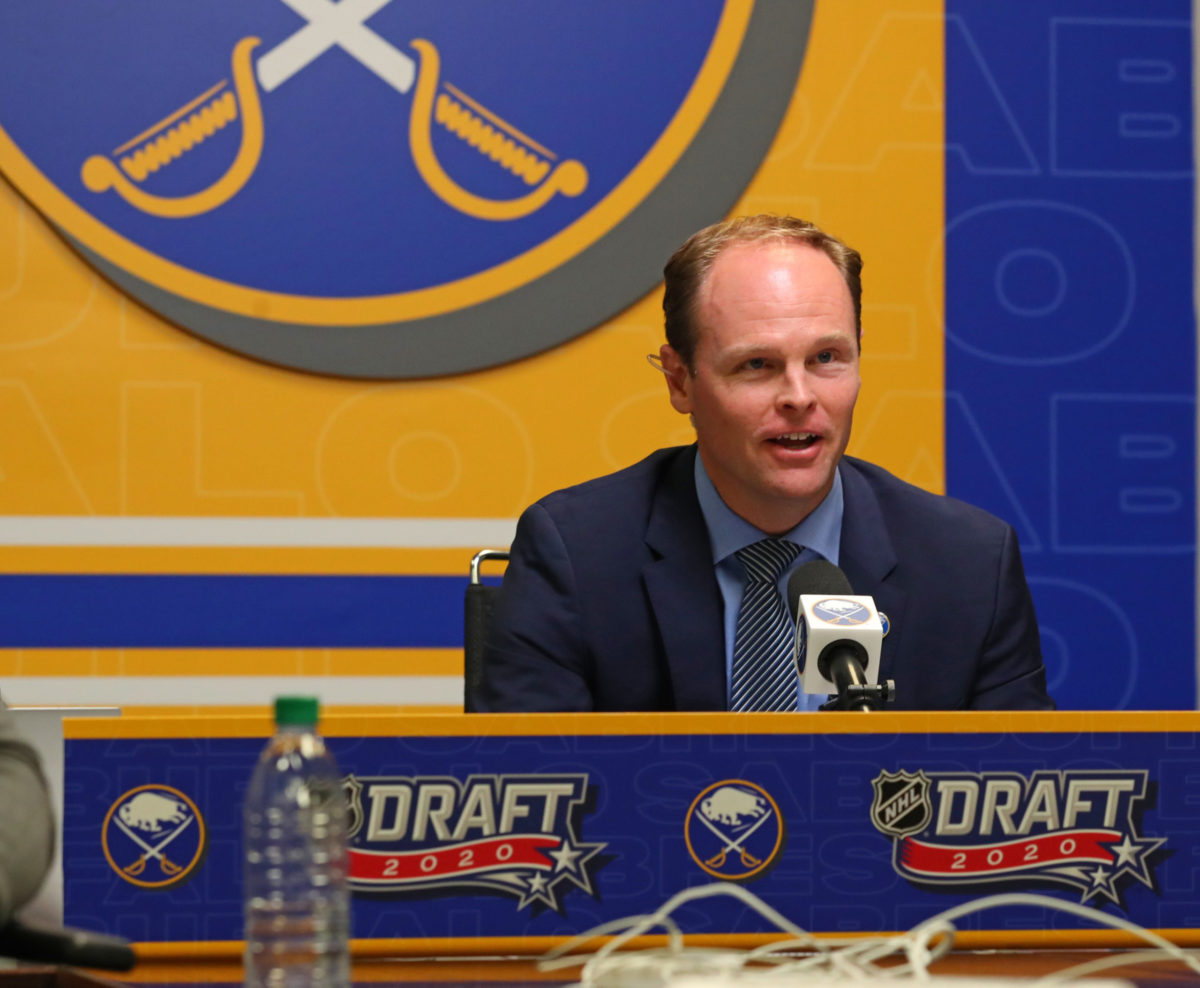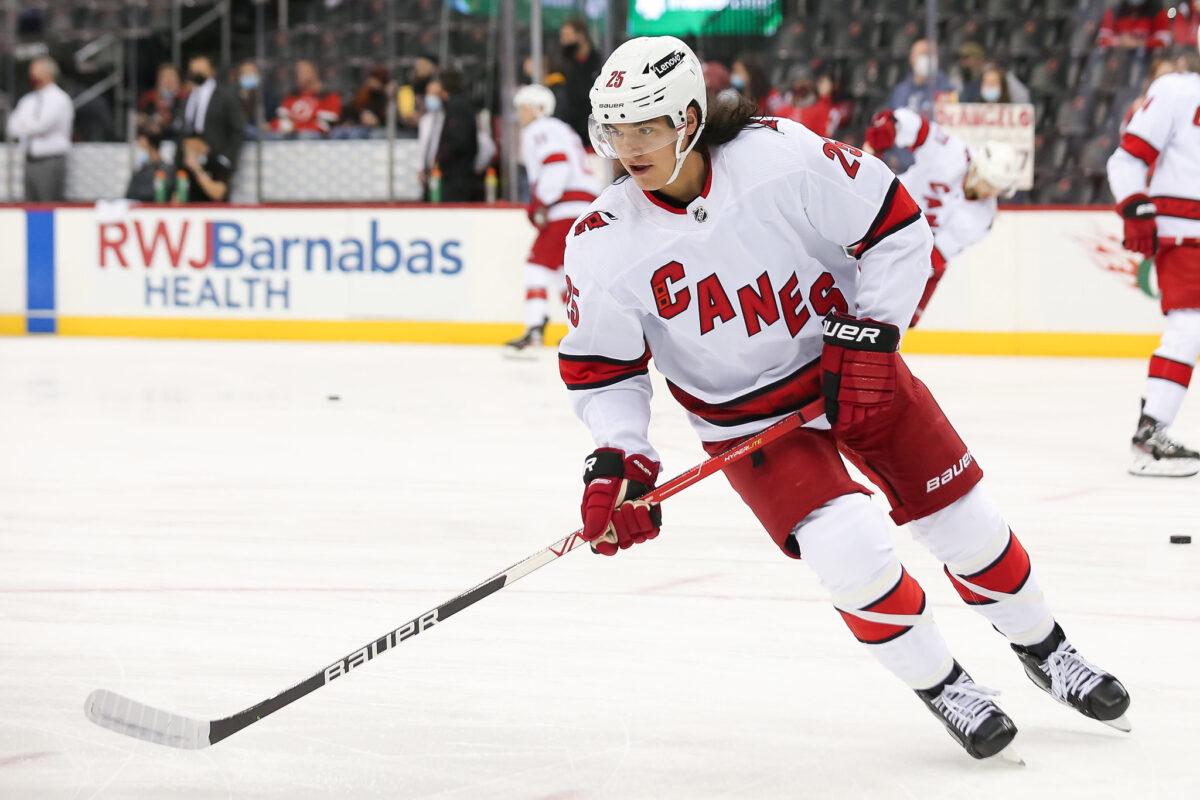There is a particular theme around the Buffalo Sabres this offseason: they have options. Whether it be what to do with their excess salary cap space, who is going to be the starting goaltender to start the season, or who the defense partner will be for Owen Power, they have more questions than answers at the moment. With the NHL Draft rapidly approaching, the Sabres also have options with their three first-round selections. They could stand pat and use all three, trade the picks in order to move around the draft board, or move one or two of them to acquire a roster player. Basically, they are tremendous pieces of ammunition for general manager Kevyn Adams, as they can remain flexible in their draft strategy and proverbially let the draft come to them.
The Sabres Can Keep All Their Selections
Perhaps the most likely outcome, the Sabres can opt to use all three first-round selections to bolster their prospect pool. This draft is an interesting one as there is not necessarily a consensus on who will be the first-overall selection, let alone what the rest of the first round will look like. There could be some twists and turns throughout, and Buffalo can afford to wait and see who is available to them at each selection.

If they choose to go in this direction, the Sabres would benefit from their recent stretch of drafts where they added quality prospects to their organization. Without a clear-cut need, they can draft the best player available at each spot. If they choose to select a forward at pick nine, for example, they can really go any direction they choose with picks 16 and 28 because there is not one glaring need. It would be beneficial for Adams to spread his picks out and add to multiple position groups while he has the chance to do so.
Moving Around the Draft Board Would Be Solid Asset Management for the Sabres
Because of the uncertainty surrounding the top ten of this draft, trading up or down will certainly remain on the Sabres’ radar. If one of their highly ranked players begins to fall below where they expected him to land, they could use one of their selections this year, or one of their three second-round selections they have in next year’s draft to slide forward. Conversely, if they are on the clock and don’t particularly like how the board has turned out, they can move back a few spots and pick up an extra draft pick or two in the process.

In a nutshell, their draft pick stockpile allows them to move freely around the board. Either moving assets to get the player they want or moving down to wait for someone, all while acquiring additional picks in the process. The Sabres have done an excellent job of accumulating draft picks through trade in recent years, and asset management like this can be a major tool in helping the organization take a major step forward.
Using One of the Selections as Trade Bait Could Help the Sabres Now
After the Los Angeles Kings dealt their first-round pick and Brock Faber to the Minnesota Wild for Kevin Fiala, we have a clearer picture of the cost of acquiring a high-end forward. With the Sabres holding three first-round picks, it is not out of the realm of possibility to think they could make a similar deal for a player they covet. They have needs at virtually every position and there are certainly some intriguing targets available, so let’s have a little fun with some hypothetical players they could trade for.
Alex DeBrincat
Perhaps the biggest name rumored to be available, Alex DeBrincat is an elite winger who will give you 30 goals a year. The Sabres have the assets to put together a package for him, the question would be how they make the salaries work. With Jeff Skinner making $9 million a season, they would likely be committing over $20 million to two players when DeBrincat signs his new deal. If the Sabres did make this move, it would be a giant step for them towards competing for a playoff spot in 2022-23.
Jesse Puljujarvi
A restricted free agent (RFA), Jesse Puljujarvi is an interesting trade candidate for the Sabres to consider, as he is a strong defensive winger who has had some bad luck with finishing his scoring chances. Due to his age, potential, and RFA status, he would be a solid addition to their forward group.
Related: Sabres Have Good Internal & External Options to Fill Out Forward Group
It likely would not take a first-round selection to acquire the rights to negotiate with him, but even if that was the cost, the Sabres are in a good position to make that move. He has the upside they would be expecting from their 16th or 28th overall selection, but he is NHL-ready now and can step into their lineup next season. All in all, it would be a low-risk and potentially high-reward trade scenario the team should consider.
Ethan Bear
The Sabres need a right-handed defenseman they can pair with either Rasmus Dahlin or Power. Bear also carries an RFA tag and would require a new contract if he was acquired. He is an undersized, mobile defenseman who would be able to skate well with either Dahlin or Power and could anchor a power play if needed.

Acquiring him would likely require less than a first-round pick, but they could potentially use one of them to move back in the draft. Doing so would allow them to add more assets, therefore offsetting the cost.
Alexandar Georgiev
The New York Rangers may not be able to extend a qualifying offer to Alexandar Georgiev, but the Sabres would be wise to try and negotiate with him before he hits free agency. The biggest question surrounding the Sabres right now is goaltending, and the possibility of adding a 26-year-old goaltender to their team is an exciting one. Georgiev is ready to compete for a starting role, and the Sabres would provide a vessel for him to show what he is capable of. They could offer him a short-term deal so they can see if he fits and then decide whether to commit to him long-term or not.
This draft is a monumental one for the Sabres because of all the different avenues they can take. Drafting three first-round players would be a tremendous way to keep their prospect pipeline stacked, and moving up or down gives them opportunities to get a player they highly covet or acquire more assets for future drafts. Finally, they could also use one of the picks to improve their current roster and signal a shift towards being a competitor. Ultimately these picks allow the Sabres to remain flexible in their approach. They can afford to see how the draft is progressing and then make the best decision for the team when the time comes, whether that be to help the team now or in the future.